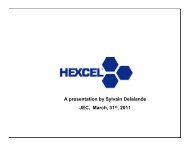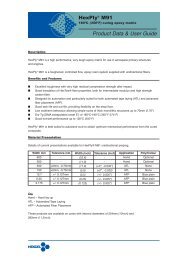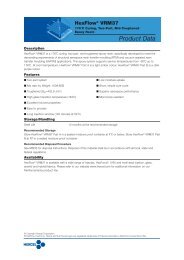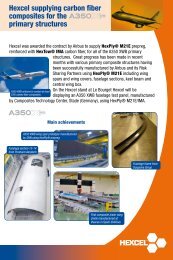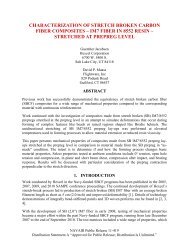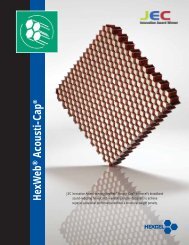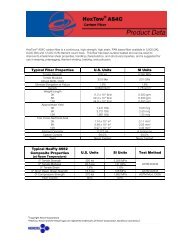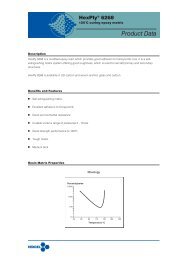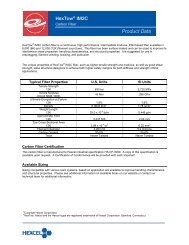failure initiation and effect of defects in structural ... - Hexcel.com
failure initiation and effect of defects in structural ... - Hexcel.com
failure initiation and effect of defects in structural ... - Hexcel.com
You also want an ePaper? Increase the reach of your titles
YUMPU automatically turns print PDFs into web optimized ePapers that Google loves.
1. Molded-<strong>in</strong> <strong>defects</strong> (1.27 cm x 1.27 cm brass covered with Teflon ) imbedded between<br />
HexMC plies<br />
2. Visible damage from impact<br />
3. Incidental damage: cuts made with a saw <strong>and</strong>/or visible surface damages<br />
These <strong>defects</strong> were located <strong>in</strong> high stress areas <strong>of</strong> the parts as determ<strong>in</strong>ed by <strong>structural</strong> analysis<br />
<strong>and</strong> verified by test<strong>in</strong>g <strong>of</strong> the prist<strong>in</strong>e parts. Parts always had a <strong>com</strong>b<strong>in</strong>ation <strong>of</strong> <strong>defects</strong> <strong>and</strong><br />
damage. All parts were tested statically <strong>and</strong> many were also tested <strong>in</strong> fatigue depend<strong>in</strong>g on the<br />
application. The fatigue cycle typically represented the service load for three times the design<br />
life <strong>of</strong> the airplane. All parts survived the fatigue test<strong>in</strong>g <strong>and</strong> were subsequently tested to <strong>failure</strong><br />
<strong>in</strong> static. The <strong>failure</strong> load <strong>of</strong> these parts after fatigue was the same as non- fatigued parts. Even<br />
fatigued parts with <strong>defects</strong> had the same static strength as prist<strong>in</strong>e parts that had not been<br />
submitted to fatigue.<br />
Figure 4 shows typical results from a series <strong>of</strong> tests on prist<strong>in</strong>e parts <strong>and</strong> parts with molded-<strong>in</strong><br />
<strong>defects</strong> <strong>and</strong> that were also damaged.<br />
Figure 4. Example <strong>of</strong> static test results for three sets <strong>of</strong> parts with <strong>and</strong> without <strong>defects</strong>.<br />
Even with substantial <strong>defects</strong> <strong>and</strong> damages, this <strong>com</strong>plex 3D part had no loss <strong>of</strong> part strength.<br />
Each square dot represents a test. Statistical analysis shows all the results fall with<strong>in</strong> the same<br />
population. Further, the impact “footpr<strong>in</strong>t” as detected by ultrasonic test<strong>in</strong>g was found to be<br />
smaller for DFC than for CFC (QI lam<strong>in</strong>ate <strong>of</strong> same thickness).<br />
Conversely, when parts are produced with a Quasi Isotropic lay-up <strong>of</strong> the same batches <strong>of</strong><br />
8552/AS4 UD used to make DFC parts, sensitivity <strong>of</strong> Barely Visible Impact Damages (BVID)<br />
reappears. An example is shown <strong>in</strong> Figure 5 <strong>and</strong> Figure 6.




